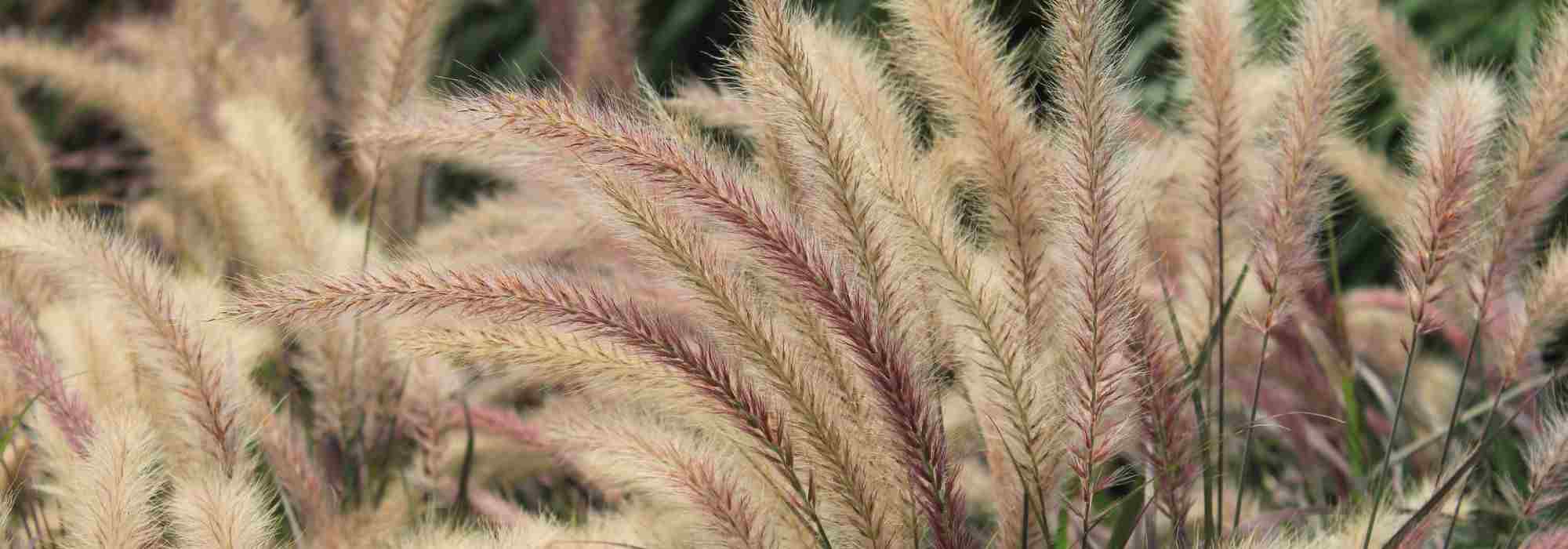
Feathery inflorescences
6 plants to discover
Contents
Highly decorative and stunning in dried bouquets, the plume-like inflorescences attract us with their soft and silky appearance. It’s hard to resist touching them! These flowerings can vary greatly from one genus to another. While some grasses impress us with their very large panicles resembling dusting feathers, others surprise us with their miniature size. Depending on the plant, numerous displays await us: the plants with a flexible habit dance gently in the wind, the spikes holding morning dew shine brilliantly under the sun’s rays, while others with warm colours warm the atmosphere and the transformists change appearance with the seasons. Here is our selection of 6 plants with plume-like inflorescences, from the largest panicles to the smallest!
Cortaderia selloana ‘Rosea’
Pampas grasses are well-known for their white inflorescences. Here is a variety that stands out due to the colour of its panicles: they are pink! The Cortaderia selloana ‘Rosea’ or pink Gynérium boasts large silky pastel pink plumes from August to November, measuring 30 to 50 cm! This tall grass can reach up to 1.80 metres in height and is resistant to wind. Note that its linear grey-green foliage should be handled with gloves, as it can be sharp. Be aware that Cortaderia is considered an invasive plant in some regions. Check out our blog article Invasive plant or troublesome plant: let’s not mix them up! for more information.
The Cortaderia selloana ‘Rosea’, which loves sunlight, thrives in large groups surrounded by perennials such as Vernonias and Eremurus, or other grasses like Molinia and the white Pampas grass Cortaderia selloana ‘Evita’.
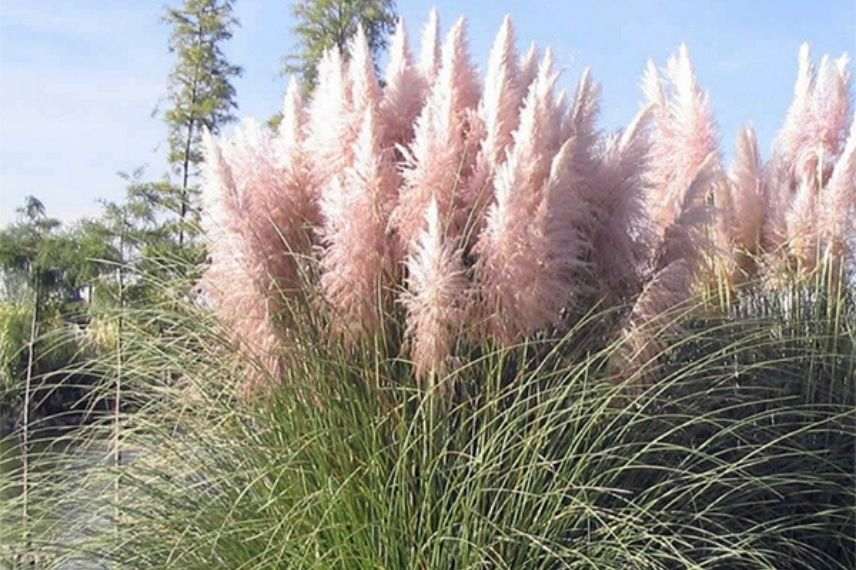
Cortaderia selloana ‘Rosea’
Discover our extensive range of Cortaderia!
Everything you need to know about Pampas grass, Cortaderia: planting, care.
Read also
Pennisetum: 7 ideas to pairing themCalamagrostis brachytricha
The culms of Calamagrostis brachytricha emerge from a bristly tuft of bronze-green leaves and rise up to 1 metre high. At their tips, the spike-like inflorescences, around 30 cm in grey-pink, turning beige in autumn, reveal their beauty under a clearing after rain! The droplets clinging to the spikes shine like precious stones. This is why it is also called Diamond Grass. These tall stems bearing large soft plumes are ideal for adding rhythm to a border in full sun or partial shade. This hardy grass with a natural style adapts to all soils as long as they are kept moist.
Easy to grow, Calamagrostis brachytricha should be planted in large spaces, rockeries, and borders alongside Sanguisorbas, Aster frikartii ‘Mönch’, Monarda didyma ‘Croftway Pink’, Dieramas, and Gauras.
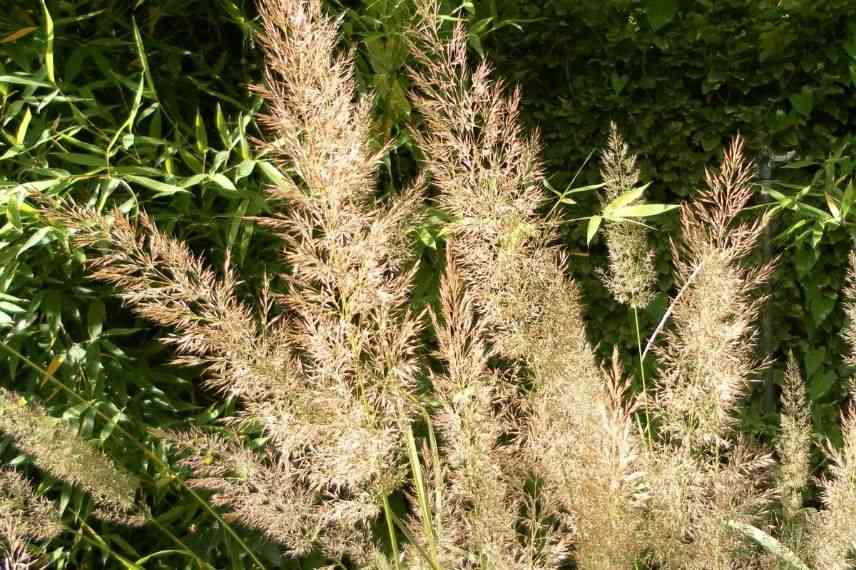
Calamagrostis brachytricha
Different varieties of Calamagrostis are available online on our site.
Calamagrostis: planting, growing, and caring for: all our tips in our dedicated sheet.
Amaranthus paniculatus ‘Autumn Palette’
The Amaranthus paniculatus ‘Autumn Palette’ is not a grass, but offers plume-like flowering in warm colours. From August until the end of summer, its large inflorescences of approximately 25 cm take on beige, brown, and orange hues. These upright plumes present a different style compared to the previously mentioned plants. They are thick, reddish stems that can reach up to 1 metre high, bearing these dense, erect panicles like flames. This fast-growing Amaranth is valued for its medicinal properties, and its broad ovate leaves and seeds are edible. Grown as an annual, it is frost-sensitive. However, it makes an excellent plant for dried bouquets, as these cut flowers retain their beauty for a long time.
The Amaranthus paniculatus ‘Autumn Palette’ finds its place at the back of a sunny border in well-drained, cool soil. Pair it with perennials or annuals such as Dahlias and Leucanthemums, the Persicaria amplexicaulis ‘Speciosa’, and the Cleome spinosa ‘Violet Queen’.
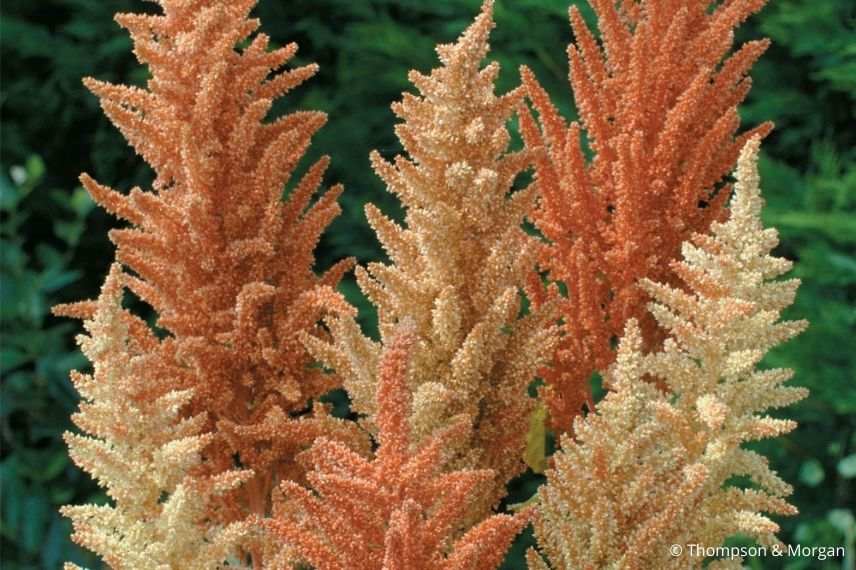
Amaranthus paniculatus ‘Autumn Palette’
A large selection of Amaranth seeds awaits you on our site.
Amaranth, Amaranthus: sowing, planting, care: discover how to plant, prune, and maintain them.
Read also
Miscanthus: best varietiesMiscanthus nepalensis
Dressed in gold and shimmering, the Miscanthus nepalensis is dazzling when exposed to sunlight. Its dense tuft of green ribbon-like leaves is topped with curved floral stems. Its golden inflorescences in pendulous spikes measuring around a dozen centimetres gradually become fluffy and white in autumn. It is its woolly plumes that give it all its charm! Non-invasive, the Nepalese Miscanthus has a more flexible habit and tends to flop more than other Miscanthus. Therefore, do not plant it too close to other plants, preferably in rich, light, and well-draining soil. In summer, it appreciates a bit of coolness. In winter, it withstands temperatures down to about -12 °C; however, young plants should be mulched for the first two years.
The Miscanthus nepalensis is perfectly suited for planting in pots, borders, or slopes. Its golden panicles pair well with Perovskia atriplicifolia, Anemone hybrida ‘Margarete’, ornamental garlic, and Aster amellus ‘Violet Queen’.
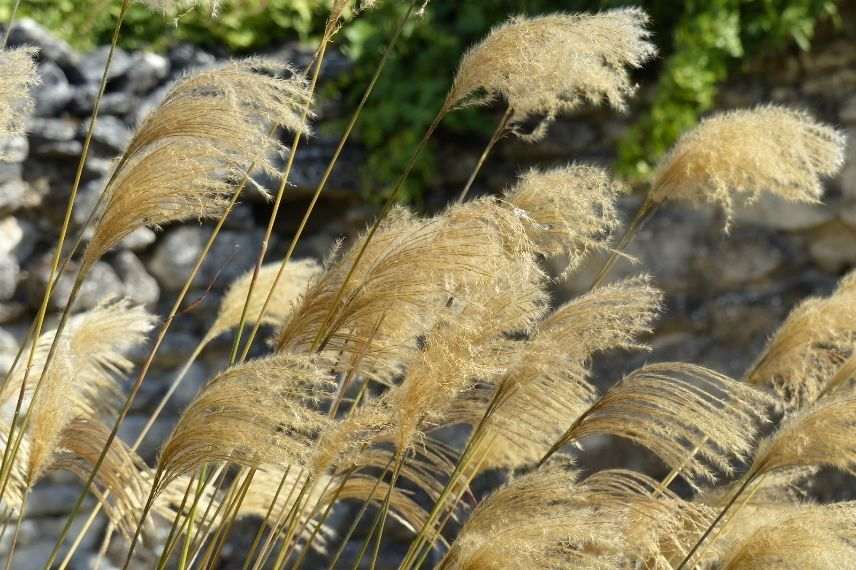
Miscanthus nepalensis (photo PBK)
All our species and varieties of Miscanthus in our online nursery.
Our tips for Miscanthus: planting, growing, and caring for
Pennisetum villosum
Graceful and delicate, the Pennisetum villosum puts on a magnificent display when the wind rises. These numerous spikes, approximately 6 cm tall, perched on flexible stems, begin to move. These soft, luminous, white inflorescences, like feathers, turn a brown colour in autumn. The dark green, fine foliage contrasts well with the floral spikes. This feathery herb with a rather arching habit enjoys sunny locations and tolerates drought well. However, it is sensitive to cold and humidity, so it is best to plant it in a pot in colder regions to shelter it during winter.
The Pennisetum villosum adds a light touch to a rockery or a border composed of Nepetas, Aubrietas, Verbena hastata, and Sedum spectabile ‘Meteor’, as well as Phlox.
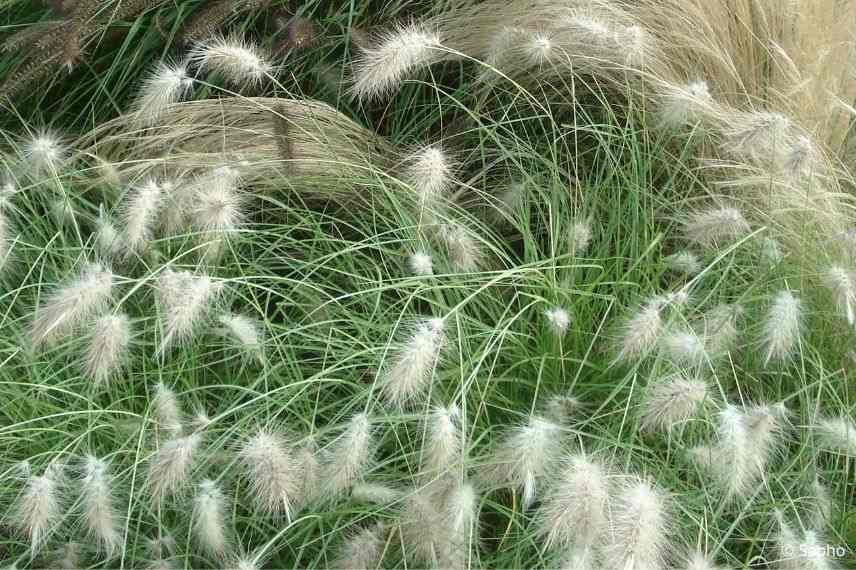
Pennisetum villosum
Discover more varieties of Pennisetums in our range.
Everything you need to know about planting, growing, and maintaining Pennisetums!
Lagurus ovatus ‘Bunny Tails’
Upon seeing the fine and delicate Lagurus ovatus ‘Bunny Tails’, one can’t help but want to touch its soft and silky white spikes! Above its tuft of linear leaves, these ovate inflorescences, measuring 2 to 4 cm, stand tall from June to October, initially tinged with green and pink, then turning white and finally golden. Its foliage also changes colour over time, transitioning from green to blonde before finishing as a brownish-gold. This small grass (25 cm in all directions) is easy to grow and is planted as an annual, as it fears frost. Found around the Mediterranean and the west coast of France, Lagurus thrives in sandy soil, coastal areas, and scrublands. With unparalleled elegance, Lagurus ovatus ‘Bunny Tails’ is often used for creating dried flower bouquets. Preferring sunny situations and being low-maintenance, the Dwarf Hare’s Tail (or Big Kitten) only requires well-drained soil to flourish. It enjoys being at the edge of borders, in rockeries, as well as in pots.
In a border, its combination works wonders with some Helianthus in the background, followed by Agastache rugosa ‘Blue Fortune’ and the graphic Buenos Aires Verbena. Next, the bright yellow Rudbeckia fulgida ‘Goldsturm’, Echinacea purpurea ‘Sunrise’, and Cosmos ‘Sonata White’ intersperse. At the front, Lagurus is accompanied by Carex oshimensis ‘Evercream’ and Helianthemum ‘Wisley Primrose’.
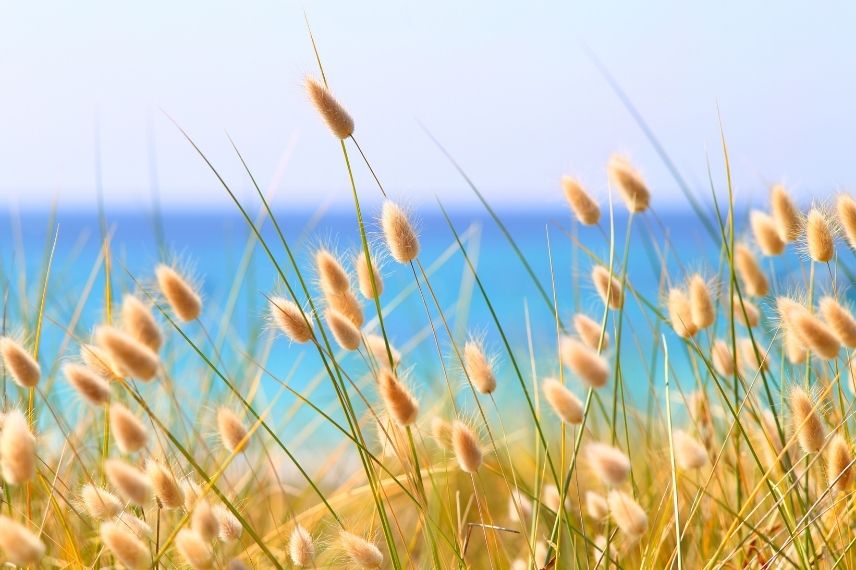
Lagurus ovatus
- Subscribe!
- Contents
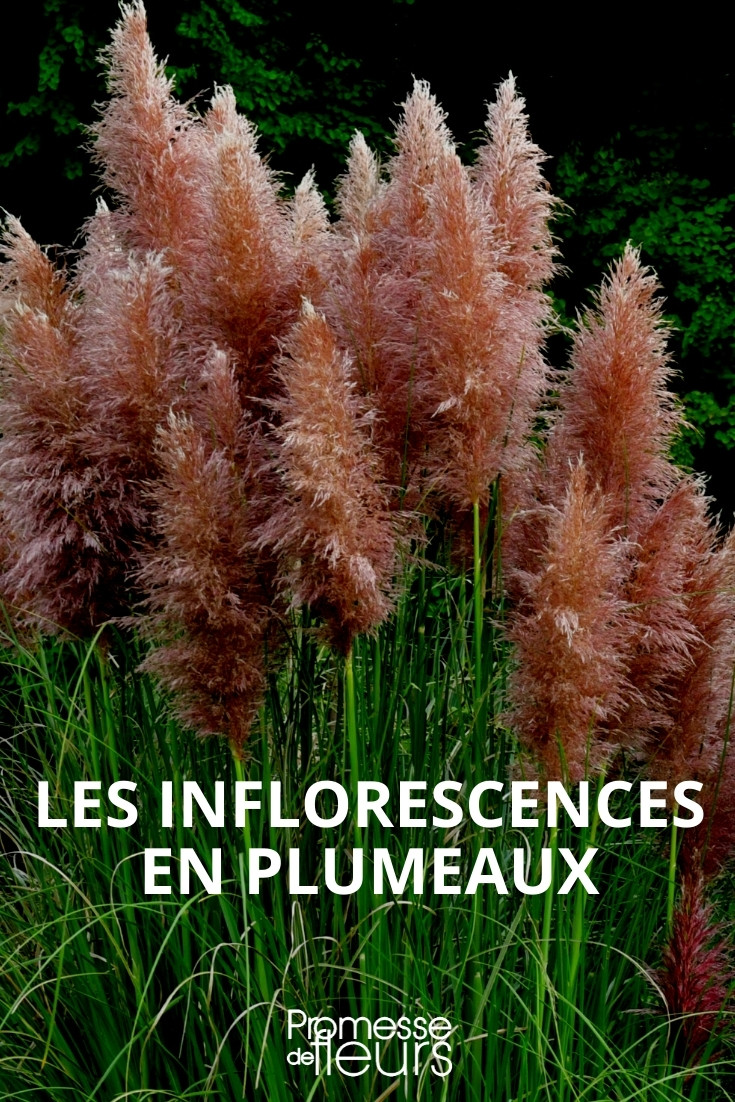































Comments